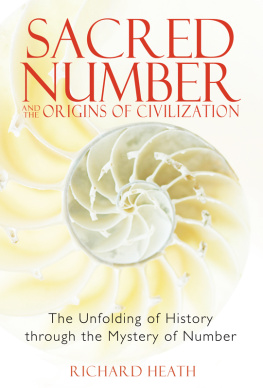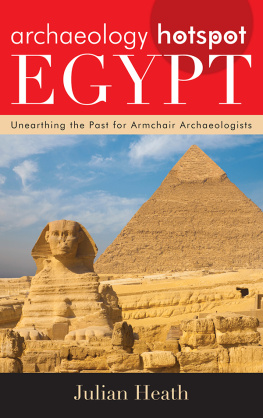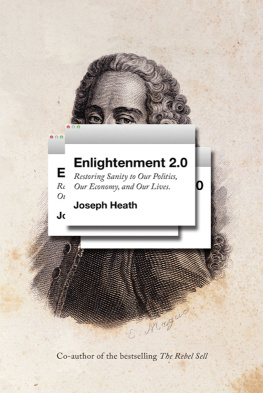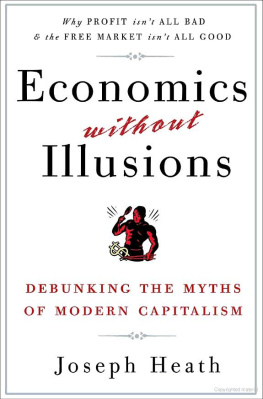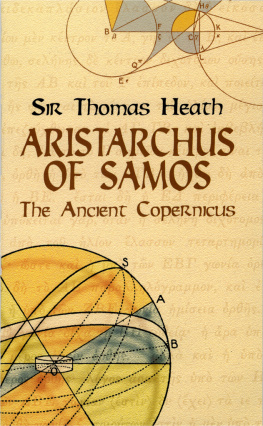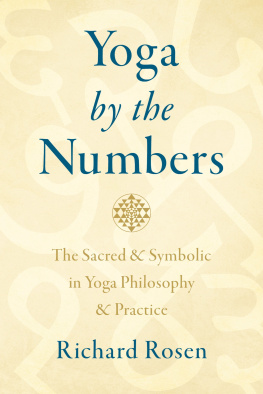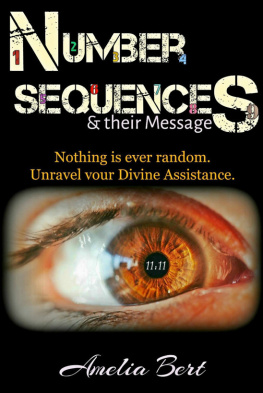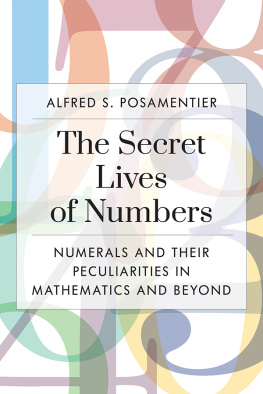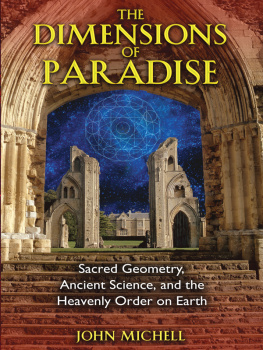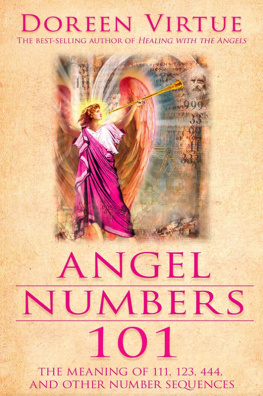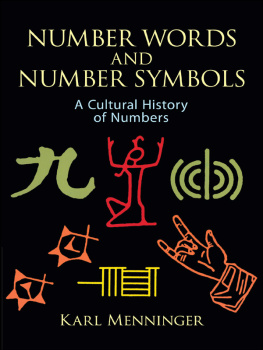SACRED NUMBER
AND THE
ORIGINS OF CIV ILIZATION
Books such as this must be read if we are to hold back the New Dark Ages. Heaths book is profound and the product of years of study and thought. These things have been kept from us by institutional forces and preserved in secret. Only an understanding of these principles can save us.
ROBERT TEMPLE, AUTHOR OF
ORACLES OF THE DEAD AND
THE SIRIUS MYSTERY
SACRED NUMBER
AND THE
ORIGINS OF CIVILIZATION
The Unfolding of History
through the Mystery of Number
RICHARD HEATH

Inner Traditions
Rochester, Vermont
ACKNOWLEDGMENTS
This book is the product of a wide range of ideas, and a sequence of very productive coincidences. Many of the ideas utilized to build the bigger picture are the result of John Michells investigations into subjects such as the ancient science of numbers or metrology, centrism, twelve-tribe nations, Jerusalem, and the Michael Lines. John Neal has provided a complete systematic approach to the metrology that has been crucial in the identification of monumental designs such as Carnac and Washington, D.C. Robin Heaths re-discovery of Britains large landscape triangles and megalithic techniques and units of measure has enhanced and enabled my approach. Howard Crowhurst provided AAK (Association Archeologique Kergal) data on Carnac and hosted a guided tour in kilometers. Paul Broadhursts books confirmed the significance of the Michael Lines, which formed a major thread of historical investigation. Tom Grahams grid for Bornholm gave me a vital clue to the metrology there. Rick Campbells website on Washington, D.C. identified the basic pattern. Robert K. Temples persistence in studying oracles and hexagonal geometries helped focus on root three as a unifying phenomenon.
My step daughters, Jessica and Joanna, helped by living in places that led to valuable results in Crete and Cathar country. The DuVersity enabled me to connect to Chartres and Carnac through leading the Enchanted Albion tour with Anthony Blake. A brief stint doing tours at Rosslyn Chapel and other Celtic Trails brought me into the crazy world of Templar-related mysteries such as the Rose Line meridian.
Wikipedia has to be praised for making so much more possible for research and the efficient checking of facts. Google Earth might have been invented specially for this book, for the provision of effective visualizations of landscape geometries and also for providing land measurements that would otherwise require specialist maps and much more labor. Thanks to Anthony Blake for intelligent readings and dialogue throughout.
Thanks also to Robin Heath for copyediting his review manuscript and to Inner Traditions for publishing this work. Finally my wife, Jane, has to be commended for supporting an interminable process of research that appears only now to have been conclusive.
INT RODUCT ION
NUMBER AND CREATION
A corpus of ancient knowledge lies behind many of the worlds historical culturesand, in fact, provides a foundation for our modern culture even though we no longer share the worldview that produced it. In this prehistoric culture the world was seen as a manifestation of numerical powers. The ancients worked out a system that described the whole world and cosmos numerically and deduced that it had been created by a recognizable intelligence; this assumption gave birth to religious speculations that literally sought to reconnect to the source of it all. This book will explore the protoculture for which this was the organizing idea, which has become popularly known as Atlantis.
Two things that are expected when Atlantis is mentioned will, however, not be found here. There is almost no discussion of where Atlantis may have existed and there is also scant mention of the catastrophes that were said to have destroyed it. While there are numerous books with many versions of where Atlantis was and how it was destroyed, this work emerged instead from the identification of specialized cultural material that can only have come from a source such as Atlantis. This cultural material is numerically based.
Numerical knowledge does not rely on the noisy channels of history, archaeology, ancient languages, artifacts, myths, scripture, and so on. Like the phoenix, it is perfectly reconstructible because number itself is a set of eternal archetypes. Indeed, if the ancients had a numerical science, then numbers are its operators and these have essentially not been damaged by the passage of time. Provided as we are with sufficient clues surviving from the past, then the ancient science is to a great extent a selfreconstituting whole once the area that it dealt with has been exposed.
This book is an overview based upon the ongoing work of just a few people engaged in different aspects of this reconstruction, in order to see what the ancient science might have looked like and how it was then transformed during the historical period. I introduce the subject matter with this theme in mind, and more detailed sources provide a necessary further resource on each of the subjects covered, as mentioned in the footnotes.
This reconstruction can itself be seen as an emerging science, or protoscience, which, like all such, is well expressed as being an elephant in the dark. Different people form different views based upon their perspective, methodology, and so on, some touching the tail, others sensing the breath, and others studying the sound. Thus the work being done to recover the original and objective system of prehistoric thought includes parts of religion, science, art, traditional stories, calendric practices, sacred geography, ideas held by fringe groups, oracular techniques, and so on.
This side of human nature, that can work with higher energies of consciousness and creativity, is perpetually in the dark, a cloud of unknowing and a dark night of the soul. Those that ridicule it are evidently just not drawn to it. The secret is to be able to see in the dark, where no one wants to look. Cultures define themselves by what is illuminated and what is in darkness. One cannot deny therefore the simple equation that new knowledgewhich in this case happens to be old knowledgewill not initially seem attractive. Between religious belief and scientific certainty lies a region in which new beliefs and great uncertainties exist. This is uniquely an area of human work in that something new can arise, something latent that connects with the cosmic principle of creation and creativity.
The advantage of focusing on the numerical cultural traditions of prehistory is that, within the world of number, there are factual manifestations such as musical harmony, aesthetic proportions, astronomical periodicities, known ancient measures and monuments built with them, and geometrical archetypes.
In the dark ages that followed the destruction of Atlantis, however, the numerical powers that the ancient culture understood as giving rise to all creation became symbolized as gods. The early historical period became filled with symbols, iconographies, and myths that were degenerate components of the numerical worldview. Numerical realities were characterized by association to corresponding objects and human characteristics. Scholars have identified storm gods, fertility gods, trickster gods, and so on, but not the system that lay behind them. This has been extraordinarily confusing, for it has meant that scholars could get lost within a system of signs and symbols that often led them to the conclusion that the ancients engaged in a massive pathetic fallacy, that is, that they were superstitious savages.
On the other hand, out of prehistory we see some of the grandest physical systems, in the form of pyramids and circles made of large (mega) stones (liths), which display an exactness in form and number that does not fit with highly superstitious tribal behavior or within a simplistic pathetic fallacy. A more plausible explanation of megalithic constructional achievement is to suggest that an elite
Next page
